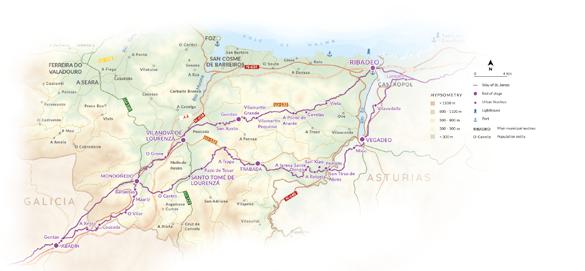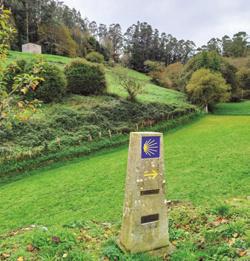
3 minute read
The Northern Way of St. James

Making a pilgrimage to Santiago is for many a unique and transformative experience, a special way of getting to know both the places along the way and oneself.
Advertisement
The Northern Way of St. James, which passes through A Mariña, was declared a World Heritage Site in 2015 by virtue of its undoubted cultural value. It is as old as the French Way, chosen by European kings as a route to visit the Apostle’s tomb in the Middle Ages. It is currently the third most frequently used in terms of numbers of pilgrims, after the French and Portuguese Ways, respectively, and is relatively quiet, with some beautiful landscapes. It enters Galicia via Ribadeo, crossing the Os Santos bridge, to continue through Barreiros; or further south, through Trabada from Santiago de Abres. After passing through Lourenzá and Mondoñedo, the Way continues on towards Abadín, now in A Terra Chá, climbing steeply from the coast.
As well as a network of public hostels that already existed in Ribadeo, Trabada, Vilanova deLourenzá and Mondoñedo, in recent years some new ones have opened, improving accommodation options along the Way and allowing pilgrims to learn about our important ecclesiastic and civil heritage and discover the nooks and crannies of our landscape – made all the easier to discover on foot –, our delicious gastronomy and the genuine kindness of its people. ¡Buen Camino!
Nature activities
The geographical diversity of this destination opens the door to a variety of activities to be enjoyed in the natural environment, from simply watching and discovering to dynamic alternatives for the most adventurous among us. The rias provide a natural shelter, perfect for the enjoyment of nautical sports all year round, and the accessibility and orientation of the beaches make it a perfect spot for surfing.
Nautical sports facilities, town councils, specialist guides and more than twenty companies devoted to sports and adventure activities provide numerous interesting options for beginners and experts alike.
Surfing, windsurfing, kitesurfing, paddle- boarding
Guided boat trips
Boat hire
Snorkelling and Diving
Canoe and kayak expeditions (routes/trips)
Water-skiing, wakeboarding
Trekking, trail running, BTT trails
Horse-riding
Caving
Paragliding
Canyoning
Rock climbing and rappelling
Recreational sea fishing and river fishing
Zip wire
Visits led by experts to places of cultural and natural heritage interest in the area and specific mycological, ornithological and geological trails.
Ornithological Tourism
A Mariña Lucense provides excellent sites for bird watching. The annual migration of thousands of sea birds can be observed from any of the numerous headlands, and especially well from Cabo Burela. Three places have been declared Special Protection Areas for Birds (SPAs), fundamental for the preservation of several species, as numerous waterfowl find shelter there on their migratory journeys or because they provide excellent breeding grounds.
The Coast of A Mariña Occidental provides shelter for colonies of sea birds, with an important population of ostrero euroasiático. The Foz ria is home to a varied community of waterfowl in winter and in the autumn migratory period: spoonbills, gulls, anatidae and waders. In the estuary, significant wintering populations of curlews and bar-tailed godwits gather. The Ribadeo ria is a resting place for water birds, especially for wintering Eurasian wigeons and northern pintails. Species of mountain birds that are scarce in Galicia breed in O Xistral mountain range, such as the citril finch, the Eurasian siskin and the red crossbill.
Geoturism
This destination is a must for geotourism lovers in Spain. The unique shapes of the coastline are a testimony to the evolution of the terrain resulting from the interaction of different factors, such as: the rocky substrate, the power of the waves, tidal phenomena, or the action of saltpetre on the rocks. Quartz, slate, shale, gneiss and granite are all predominant, often revealing large faults and folds, as can be seen in Burela, which boasts the best-preserved group of folds in Galicia. The erosion of these substrates and the transportation and deposit of sediments gave rise to the sea caves (“furnas”), blowholes (“ollos”), islands, islets and arches that are characteristic of this coastline and whose maximum expression can be seen at the As Catedrais beach.
Some borough councils, including Burela and Ribadeo, are pioneering in their promotion of geological routes to learn about the origin, formation and evolution of this region.
Trekking
Because lacing up your boots and walking is the healthiest, most natural and rewarding way to understand the environment, we would encourage you to discover our walking trails, scattered throughout the region and offering a variety of different lengths, difficulties and landscapes. Trabada, O Vicedo and A Pontenova, have approved trails and in almost all of the boroughs there are options that allow walkers access to our autochthonous forests and riverside woods in mountain and coastal surroundings.
There are two Nature Trails in A Mariña: one belonging to the Cantabrian Route, covering a distance of 131 km along the entire coastline, which we recommend dividing up into 7 stages, and the San Rosendo trail, which links Mondoñedo to Foz, passing by San Martiño Basilica.






